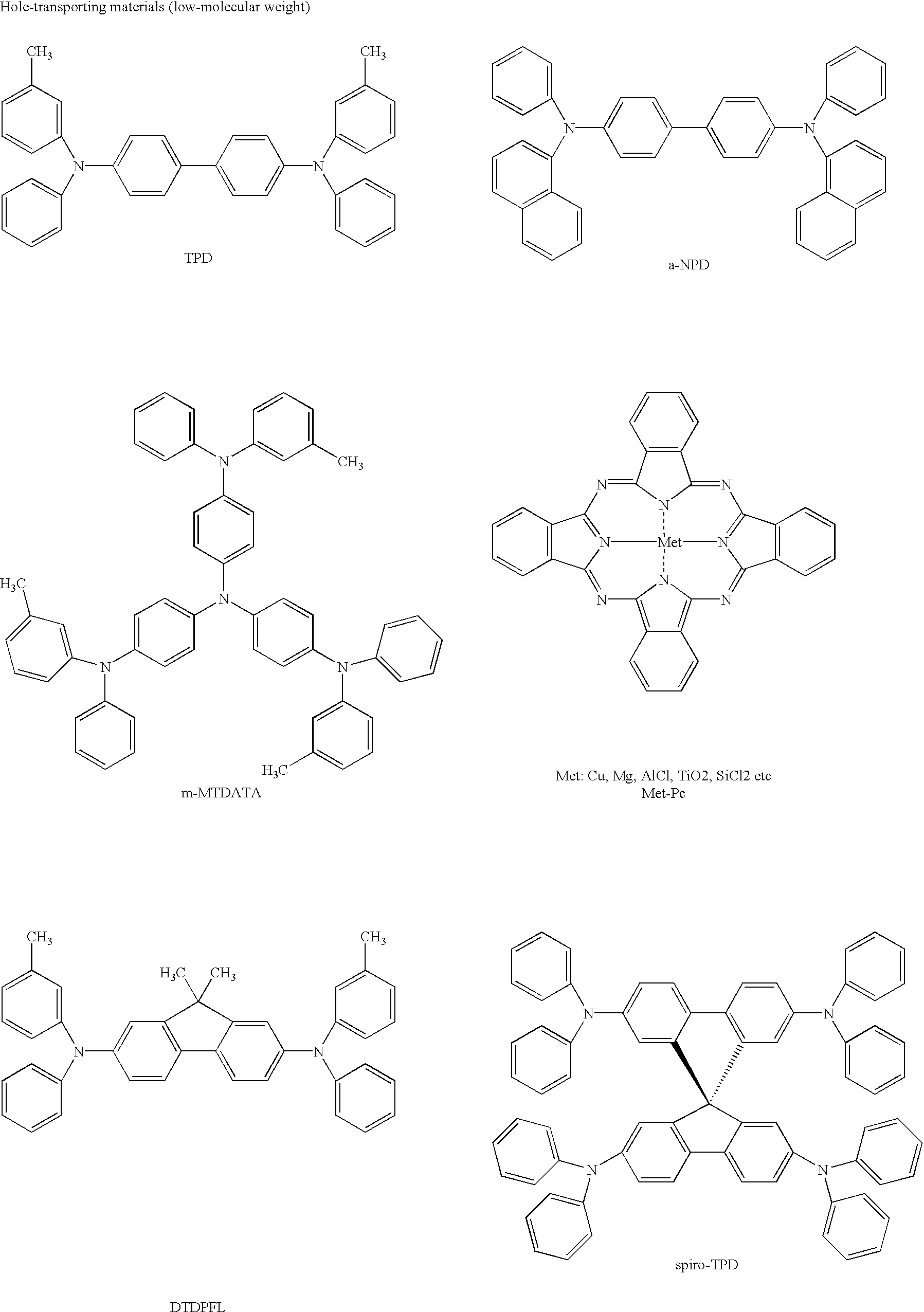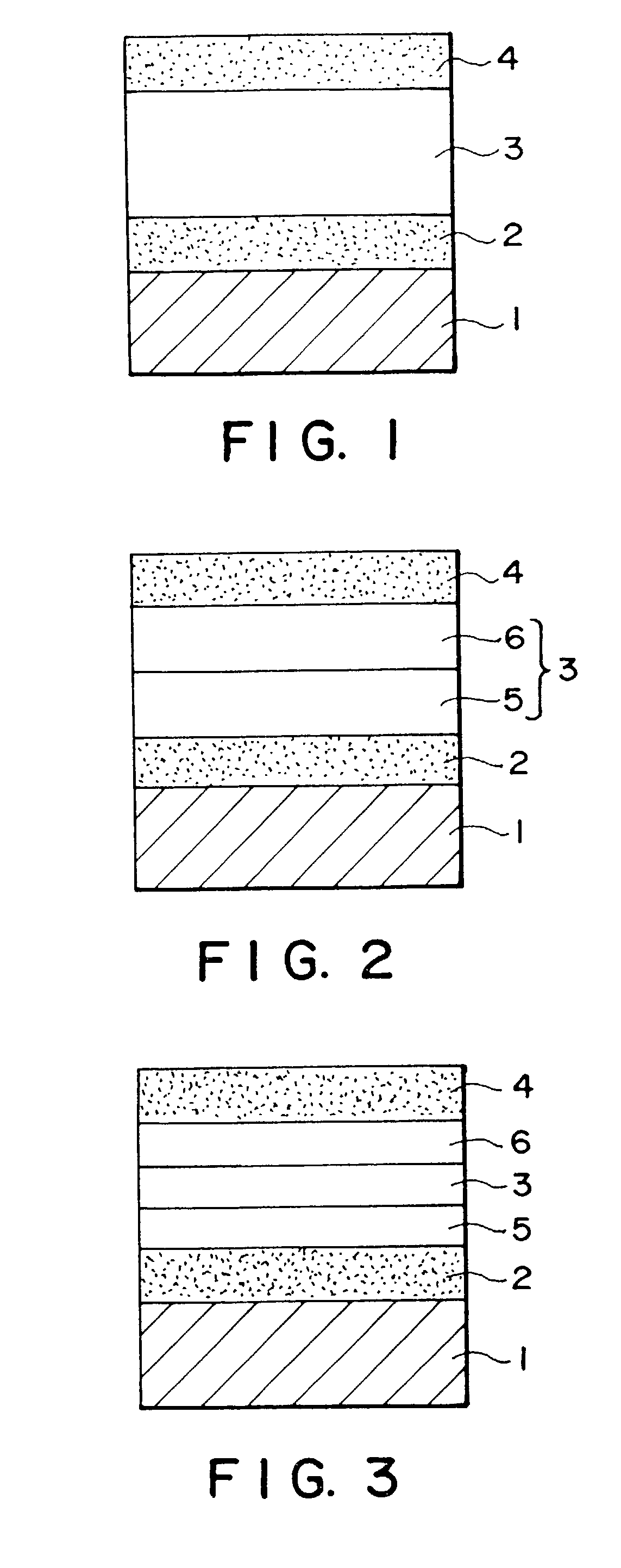Organic luminescence device and process for production thereof
a luminescence device and organic technology, applied in the direction of discharge tube luminescence screen, natural mineral layered products, transportation and packaging, etc., can solve the problems of deterioration, insufficient durability of luminescence devices, and devices liable to change in their properties
- Summary
- Abstract
- Description
- Claims
- Application Information
AI Technical Summary
Benefits of technology
Problems solved by technology
Method used
Image
Examples
example 2
[0055] An ITO-coated transparent conductive substrate identical to the one used in Example 1 was coated with DPDVDAB used in Example 1 by vacuum deposition at a film growth rate of 0.3 nm / sec in a vacuum of 1.0.times.10.sup.-4 Pa to form a film thereof, which was then irradiated with ultraviolet rays for 5 min. and then heat-treated at 120.degree. C. for 2 hours to form a 50 nm-thick polymerized film (as a hole-transporting layer 5).
[0056] Thereafter, the polymerized film was coated by vacuum deposition successively with a 50 nm-thick film of Alq.sub.3 (electron-transporting luminescent layer 6) and a 150 nm-thick Al--Li alloy (cathode film 4) similarly as in Example 1 to form an organic luminescence device having a structure as shown in FIG. 2.
example 3
[0059] 1 wt. part of N,N'-diphenyl-N,N'-bis(4-vinylphenyl)-4,4'-diamino-1,-1'-biphenyl (DPDVDAB) and 1 wt. part of methoxyethylhexyl-p-phenylene-viny-lene (MEH-PPV) were dissolved in 148 wt. parts of para-xylene to form a coating liquid (solid content: 1.33 wt. %). The coating liquid was applied by spin coating (2000 rpm) on an ITO-coated transparent conductive substrate identical to the one used in Example 1, followed by drying at 80.degree. C. for 10 min. and heat-treatment at 120.degree. C. for 10 hours, respectively in a nitrogen atmosphere, to form a 70 nm-thick polymerized film.
[0060] Then, the polymerized film was coated with a 150 nm-thick cathode film (layer 4) of Al--Li alloy (Li content=1 atm. %) by vacuum deposition at a film growth rate of 1.0-1.2 nm / sec in a vacuum of 1.0.times.10.sup.-4 Pa to form an organic luminescence device having a structure as shown in FIG. 1.
[0061] The device was driven by applying a DC voltage of 10 volts between the ITO electrode 2 and the Al...
example 4
[0062] N,N,N',N'-tetrakis[3-methacryloyloxyphenyl]-4,4'-diamino-1,1'-biphe-nyl (TMDAB) and benzoyl peroxide (in 2 wt. % of TMDAB) were dissolved in toluene to form a 1.0 wt. %-coating liquid. The coating liquid was applied by spin coating (2000 rpm) on an ITO-coated transparent conductive substrate identical to the one used in Example 1, followed by drying at 80.degree. C. for 10 min. and heat-treatment at 120.degree. C. for 8 hours, respectively in a nitrogen atmosphere, to form a 65 nm-thick polymerized film (hole-transporting layer 5).
[0063] Then, 2,5-bis(4-styrylphenyl)-1,3,4-oxadiazole was dissolved in toluene to form a 1.0 wt. % coating liquid. The coating liquid was applied by spin-coating (2000 rpm) on the above formed hole-transporting layer (5), followed by drying at 80.degree. C. for 3 hours and heat-treatment at 120.degree. C. for 8 hours to form a 50 nm-thick polymerized film (electron-transporting luminescent layer 6).
[0064] Then, the polymerized film was coated with a...
PUM
| Property | Measurement | Unit |
|---|---|---|
| thickness | aaaaa | aaaaa |
| thickness | aaaaa | aaaaa |
| thickness | aaaaa | aaaaa |
Abstract
Description
Claims
Application Information
 Login to View More
Login to View More - R&D
- Intellectual Property
- Life Sciences
- Materials
- Tech Scout
- Unparalleled Data Quality
- Higher Quality Content
- 60% Fewer Hallucinations
Browse by: Latest US Patents, China's latest patents, Technical Efficacy Thesaurus, Application Domain, Technology Topic, Popular Technical Reports.
© 2025 PatSnap. All rights reserved.Legal|Privacy policy|Modern Slavery Act Transparency Statement|Sitemap|About US| Contact US: help@patsnap.com


